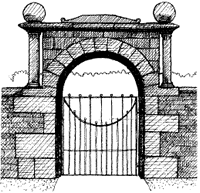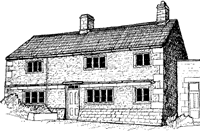Listed Buildings

The Peak District National Park has some 2,900 listed buildings. They are vital to the heritage of both the area and the nation.
What is a listed building?
These are buildings given extra protection in recognition of their importance to Britain’s heritage.
There are three grades of listing:
- Grade I for the finest buildings of most importance. Grade I listed buildings in the Peak District include Chatsworth House and Haddon Hall.
- Grade II* for buildings of exceptional quality or containing special features. Ilam Hall and Eyam Hall are examples of grade II* buildings in the National Park.
- Grade II for buildings of special interest. Around 94% of listed buildings come under this category.
Only a very small proportion of this country's buildings are listed. This fact alone makes every listed building special. Generally, the older a building is and the less it has been altered, the more likely it is to be listed. Listed properties are much sought after and this is reflected in property values.
The Buildings at Risk register
This is a list of Grade I, II* and II listed buildings and structures in the Peak District National Park in such a poor state that their future is threatened. They range from houses to bridges, historic features such as mileposts and even phone boxes.
The level of risk is assessed using standard criteria laid down by Historic England. Grade I and II* listed buildings at risk are also included on the National Heritage Buildings at Risk register.
What is covered by listing?
The whole of a building including its interior becomes listed, not just the front or exterior. Any structure attached to the main building is also listed, as are certain free-standing buildings or structures within the curtilage. Further information on curtilage can be found on Historic England's website.
Can I build within the grounds of a listed building?
You will need planning permission for the erection of all but the smallest free-standing building within the curtilage of a listed property (listed building consent, however, is not required). Planning permission and listed building consent are both dealt with by the National Park Authority.
Can listed buildings be altered?
Any work which affects the character or appearance of a listed building, inside or out, or its curtilage features, requires listed building consent. This can extend to even minor changes such as the addition of an outside soil pipe, an alteration to a window and also to internal changes. Protection does not mean that alterations cannot happen, but it ensures that change happens in a way that conserves the significance of the building.
Guidelines for alterations
- Keep alterations to a minimum and avoid irreversible changes
- Retain all architectural features - inside and out
- Do not alter existing door and window openings
- Original windows should be kept and repaired wherever possible
- Limit extensions to the absolute minimum. In some instances, no extension may be possible (see our suite of design guides on our planning pages)
- The addition of porches, rooflights, satellite dishes etc, all detract from the character of the building and all require listed building consent.
What about demolition?

The demolition of a listed building, or any part of the building, or of a curtilage feature, always requires consent. The presumption is that demolition will not be allowed except in very exceptional circumstances.
How do I apply for listed building consent?
The procedure for obtaining listed building consent is similar to that for planning applications. There is, however, no fee. Where the proposals are such that planning permission is also needed, two separate applications need to be submitted. Except in the case of minor works, applicants for listed building consent will be asked to justify their proposals, identifying the building's special character and the effect of the proposed work on that character.
It is a criminal offence to alter or demolish a listed building without permission. The penalties for this can be heavy - usually a large fine (or imprisonment) and reinstatement of original features that may have been lost.
What about repairs?
Owners are encouraged to keep listed buildings in good repair. Regular maintenance (particularly to roofs and gutters) will ensure the building stays watertight and will avoid costly repairs at a later date.
The Authority carries out regular inspections of all listed buildings in the National Park. Buildings in poor condition are put on a Buildings at Risk list. Efforts are made to encourage the repair or sale of these properties. Where these efforts fail, legal powers are available to us to ensure that further deterioration does not take place.
Guidelines for repairs
- Always repair rather than replace
- Keep as much of the historic fabrics as possible and avoid over-restoration
- Where replacement is unavoidable, use matching materials and copy original detailing exactly, on a like-for-like basis
- Use a skilled local craftsman or builder who is familiar with the local tradition.

Further information and advice
The repair, restoration and alteration of historic buildings requires specialist knowledge. For all but routine maintenance it is advisable to consult an architect or surveyor with experience of historic buildings.
The National Park Authority's Conservation Officers are happy to advise on alterations, repairs, or any aspect of historic building management. If your building is not in the National Park please contact your local authority.
Peak District National Park Authority
Aldern House, Baslow Road, Bakewell, Derbyshire DE45 1AE
Telephone: 01629 816200
Email: customer.services@peakdistrict.gov.uk

